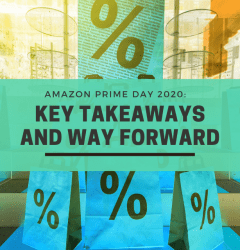This website uses cookies so that we can provide you with the best user experience possible. Cookie information is stored in your browser and performs functions such as recognising you when you return to our website and helping our team to understand which sections of the website you find most interesting and useful.
14 Oct

6 Ways to Build Brand Reputation on Amazon
When shopping on Amazon, a whopping 79% of consumers are influenced by products with the best ratings and reviews. It is, therefore, needless to say that in order to be successful on Amazon or any other marketplace, you need to be remarkably vigilant about your reputation as a seller.
In today’s age of digital presence and online sales, social proof is a driving force behind informed consumer purchases. If done right, this system is a powerful instrument of brand reputation and credibility. Hence, you need to know how to mitigate the impact of negative feedback and reviews, remain well-versed with the strategies to earn impactful reviews, and focus on the customer for the long term. There are many factors to consider when building a reputable brand on Amazon, as consumer demand and shopper traffic on the platform continue to grow exponentially.
But first, let’s understand what reputation management is.
In simple terms, reputation management involves building trust and loyalty through a seamless customer experience. On Amazon, reputation predominantly manifests itself in the form of well-managed feedback, ratings and reviews. According to a report by Spiegel Research Center, 95% of buyers go through online reviews before purchasing anything. As customers seek critical pieces of information through reviews, sellers must be proactive in facilitating transparency and providing clarifications first hand. Higher reviews and ratings mean more popularity and better conversions. Not just this, they also positively impact the product rankings on Amazon.
In this blog, we dive into a two-prong approach to maintain a stellar reputation for your brand on Amazon: a) by garnering more reviews and working towards improving the customer feedback, and b) by minimizing the negative feedback and critical reviews.
A) Ways to improve reviews and feedback on Amazon
1) Send customizable follow-up emails to garner impactful reviews
When customers feel heard, their perception of the brand improves. This is why an automated follow-up email system is an important step in reputation management. Once the customer has tried your product, a follow-up email gives them a chance to voice their opinions. These emails should add value to the buyer’s journey and have an effective call to action instead of pressing them to leave a review.
It is ideal to send the emails shortly after the customer has received your product, so it is still fresh in their mind. Also, the message added in the email should be personalized according to the product ordered by the customer. It is not recommended sending more than 1-2 follow-up emails over a time period of 7-15 days, as it hampers the buyer’s experience.
Additionally, send emails to customers who have left positive seller feedback, but did not leave a review. Be sure to add step-by-step instructions on how to leave a review to make it easy for them.
2) Curate prompt and polite responses to improve customer experience
Responding within 48 hours of receiving feedback can boost customer confidence in your product. A quick and thoughtful response also helps mitigate any negative experiences and makes room for positive brand interaction. Customers appreciate responses that are considerate, professional, and direct.
Create multiple templates beforehand to make the feedback loop fast-moving and effective. While doing so, make sure to follow Amazon guidelines by not offering any incentive in exchange for removing a review. This is considered as review manipulation by Amazon and should strictly be avoided by sellers.
In fact, in 2016, Amazon banned sellers from incentivizing their review campaigns, along with some other not-so-credible review tactics such as spamming the ‘Report Abuse’ feature on your competitors’ listings or writing glowing endorsements for your own products.
3) Utilize customer feedback to enhance your offering
Understanding key takeaways from both negative and positive product reviews can help in altering your product according to the taste of your target audience. Since reviews are unbiased in nature, it provides third-party insight into the overall quality and perception of your product. Product enhancements that take these details into account are much likely to boost your sales.
For instance, if you sell t-shirts, and you constantly get complaints about your sizes running small, it might be time for you to take a closer look at the sizing chart you follow and make necessary adjustments. At Growisto, we have developed an AI-based tool to analyze customer sentiment and reviews on our listings and also on our competitors’.
Another aspect to factor in is seller feedback, in case you are fulfilling orders on your own. It comprises customer issues pertaining to packaging, shipment, and fulfillment. Deep diving into them can prove beneficial in the case of new customers who have little to no prior experience with the brand.
4) Analyze reviews regularly to manage customer expectations
Customer feedback can give you a clear idea of what the customer expects from your product. It will help you understand decision-making factors that must be included in the product listing. For example, we noticed that one of our bedding category clients received many negative reviews pertaining to the thickness of a product. To address this issue, we altered the content to set expectations right off the bat. As a result, the negative review rate dropped significantly.
Monitoring customer reviews also allows you to report any fraudulent reviews posted by unverified or fake sources, and in turn, improve your product’s review and rating.
5) Leverage Amazon review services
- Amazon’s Request a Review Button- With the help of the Amazon Buyer-Seller Messaging system, Amazon sellers can request both seller feedback and a product review request in the same message. You can also use third-party applications listed in the Amazon Marketplace App Store to identify those service providers or tools that can help you automate the review email process and help you garner more verified reviews.
- Amazon’s Vine Program- Amazon Vine Program is a quick way to add reviews to the listings. In this, a select, trusted group of customers are invited by Amazon to leave reviews about pre-released or new products to help other customers make informed purchasing decisions. Since Amazon hand-picks the reviewers itself, Vine reviews tend to be more detailed.
Amazon had also launched the ‘Early Reviewer Program’ to help sellers generate reviews on products that had few or no reviews at all. However, as of April 2021, Amazon decided to cut-loose this program and stop all active enrollments.
B) Ways to avoid negative reviews
As a seller on Amazon, you must resolve negative feedback by investigating the root cause of each negative rating and addressing the customer’s concern in a timely manner. Following are some ways in which you can avoid negative reviews:
- Shipments and delivery: Inform the customers about the accurate shipping and delivery date, in order to avoid any confusion if you are self-fulfilling orders. In case of an error in shipment, notify customers as soon as possible and don’t hesitate to cancel the order if required. By confirming shipments within the specified timeframe, you maintain customer satisfaction and in turn garner positive reviews.
- Stock outs: By streamlining your inventory management strategy, you can proactively avoid any inventory errors and negative reviews. It is necessary to keep a minimum threshold of inventory on hand and remove any listings that are constantly out of stock. Additionally, a dedicated inventory should be kept aside for Amazon orders.
- Product Quality: By providing accurate product data, high-quality images, multiple views as well as angles of the product, and shipping products that exactly match what customers see on product detail pages, you increase your chances of receiving positive feedback.
- Customer service: It is crucial to respond to all the calls and emails within 24 hours. The contact information and email addresses provided in Amazon help pages should be accurate. By giving seamless customer service, you are increasing the chances of receiving positive reviews.
Another way to ensure that you respond to customer complaints promptly is through the Buyer-Seller Messaging Option provided by Amazon. Through this option, you can send proactive messages to customers within 30 days of their order completion. However, please be wary while using this communication method since Amazon has some very strict guidelines in place for what kind of messages are permitted here.
All in all, as online shoppers seek authentic experiences, brands that actively create a positive reputation on Amazon continue to win on many fronts. Hence, a strong brand reputation is crucial to inspire trust, stimulate purchase decisions, build loyalty, and ultimately drive conversions.
Related Post
Industries Served
United States
India













